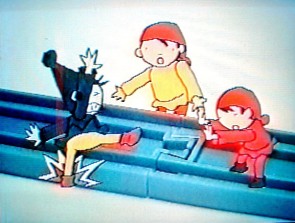After my provisional Henry that was built around Spencer's chassis and had to replace him, I felt intrigued by the idea to build scratch built frames for custom engines/powered stock that would use the "Thomas type" drive unit. Seeing as official engines with it have a conductive metal strip to finish the circuit, I thought there might be some way to achieve the same method without cutting up an existing chassis (which I can't do since I only have four remaining "Thomas type" engines). What's the likelyhood of getting a custom one to run by duplicating the metal strip with aluminium foil or similar? The motor terminal that goes under the piece holding it down would still touch the strip like the originals, though I have yet to understand how the contact right under the switch doesn't have to be connected. I'm asking because unlike the C Tender and Flat type, the "Thomas type" doesn't use wires for the motor or terminals. At least theoretically, it should be easier to get one of these to work in a scratch built chassis than the ones that need soldering. I'd love to build such versions that don't have to replace any of my existing fleet and could easily have everything swapped out when need. If there's a way to get it to work with the foil, I'll gladly attempt one and see what happens.
Conducting Power on a Scratch Built Chassis
6 Replies, 4583 Views|
Maybe I am getting your question wrong but whats wrong with soldering a wire to replace the plate?
Several reasons. One, because I have two spare "Thomas types" and only one unused Flat type (which is missing the positive terminal, the switch and its cover). The one from my custom Ivor is currently slated for a permanent conversion project. Two, the relative simplicity of the "Thomas type" chassis makes them look easier to imitate, and they can still provide power to the drive unit after being reinserted. Three, soldering would surely make the drive unit harder to remove when transferring to another model (and somewhat defeat the purpose of what I have in mind). Fourth, I've never actually soldered anything and don't have the proper environment to do so (even if I would've had the tools and safety measures for it). Not to mention, the side effects of lead and other fumes would be twice as dangerous to me, and it interests me how not all motorised items conduct their power in the "obvious" way.
I must be missing something, not unusual at my age, maybe because I can't see what you "have in mind". Good luck with your project.
Update: Sure enough, I was able to power one of the drive units with an aluminium foil strip (only touching the terminal that sticks out). Now I'll just have to find how to incorporate one into a custom chassis and have a piece press the terminal down on the foil like in the official "Thomas type" locos. The rails have been laid for the construction of not one, but two new running models with custom frames that could coexist with each other. The second DU is currently missing the switch spring and will need some minor repairs before it could be tested. Hopefully this could also facilitate building a similar DU to the "Clam Shell" and old Plarail standard, given how the wires look like they could be made from safety pins or another thin metal rod. If I could harvest the "Thomas type" from the powered ex Annie, I could've had 'three' operational custom units at the same time. Many frames I'll build for them will be modeled after it to get the same length and look and make up for how the original is (currently) defunct. It should also help me fulfill the plans I had for the original until its battery pack came off.
Let me try and clear some of this up. I've had little experience with electronics themselves and thought it would be impossible for me to build a working TOMY/TM style chassis from scratch (as opposed to a replacement body for an existing one). Watching numerous repair and restoration videos and paying attention to that conductive piece made me realise I have aluminium foil, which made me consider taking advantage of the way these units are powered. Because I have more complete rolling stock than unused parts, the components will have to be swapped out easily and allow each custom chassis (and shell) to be reusable. As stated above, I already found the answer to my question since the foil did power one of the motors and will only have to be incorporated into a (well built) custom frame.
|
Users browsing this thread: 1 Guest(s)

![[-]](https://www.blueplastictracks.org/images/collapse.png)
